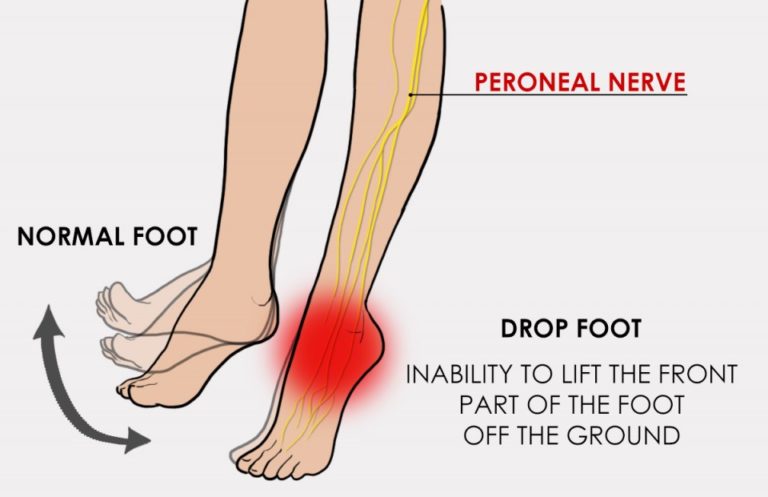10 Best Exercises For Shoulder Impingement
To alleviate the discomfort and improve shoulder function associated with Shoulder impingement, a combination of strengthening, stretching, and mobility exercises is often recommended. In this guide, we will explore some of the best exercises to help manage shoulder impingement and promote rehabilitation
Shoulder impingement is one of the most common conditions of shoulder pain. It is mostly nonspecific and comes on insidiously, meaning on its own and not from any trauma. The accurate name for the disease is subacromial pain syndrome. This is an umbrella phrase that guides to pain under the acromion, the full outer edge of the shoulder bone. As many as two-thirds of people feel subacromial pain in their lifetime, though it is more common in older adults.
People may utilize different terms to refer to shoulder impingement, including:
- Shoulder impingement syndrome
- Rotator cuff tendinitis
- Swimmer’s shoulder
Introduction:
Shoulder impingement syndrome is a common disease seen in athletes and people who perform a lot of overhead arm activities. This movement results in irritation of the rotator cuff tendon as it constantly rubs against the acromion, which is the bony process of the shoulder blade. Here are some exercises for shoulder impingement syndrome that may help reduce your symptoms:
Shoulder impingement is a broad term used to explain the irritation or injury of systems in the shoulder and subacromial space. Some models include but are not limited to, rotator cuff tendinosis (irritation of the muscle-to-bone connection), tears of the rotator cuff (partial or full tear of muscle-to-bone connection), and bursitis, which is an inflammation of the fluid-filled sacs that encircle the shoulder, impingement pain can occur in:
- The rotator cuff (the muscles and tendons covering the shoulder joint);
- The biceps tendon (which attaches the biceps muscle to the shoulder bone);
- The labrum (tissue or cartilage close to the shoulder socket); or
- Those fluid-filled sacs in the shoulder joint are called bursae.
Generally, subacromial pain is generated by an overload of tissue, meaning stress that the shoulder was not designed to bear. It could be as easy as picking up a 10-pound weight, feeling a cramp in your shoulder area, and later feeling a painful pinching sensation in your shoulder when you lift your arm. It can be typical in young athletes who bench press heavy weights without making up their shoulder strength first.
Symptoms
- Difficulty raising the arm over the shoulder height.
- It will also strain to reach the arm behind the back.
- The feeling of general stiffness and throbbing in the shoulder. A person may also see or feel swelling in their shoulder.
- The shoulder will generally ache and be stiff when at a resting position and then damaged more when the person uses it.
- It may get more harmful over time, with pain rising and strength reducing.
- Tries sleeping on the involved side of their body.
- Putting the arm over the head
- Behind the back may evolve increasingly difficult.
What are the Main Causes of Shoulder Impingement?
- Altered shoulder motion patterns might be associated with inequalities, weakness, or tightness of the muscles affected in moving the shoulder.
- Poor posture.
- Overuse.
- Repetitive overhead motions as those made while playing golf, throwing a ball, playing racquetball, swimming, or frequently reaching or lifting aloft.
- A serious shoulder injury (or trauma).
- Degeneration of the joints in the shoulder causes osteophyte formation – these are bony fragments that cause a narrowing of the space.
- Acromion skeletal anomalies that reduce subacromial space.
Diagnostic test
- The Painful Arc Test: Raise your affected arm out to the side and over your head, as though you were performing a jumping jack with one arm. If you experience pain in your shoulder when your arm goes to the midpoint or above, you may suffer from a shoulder impingement.
- The Hawkins-Kennedy Test: Cross the involved arm over your body, relaxing your hand on the opposite shoulder. Your elbow will be flexed about 90 degrees. Raise your elbow gently as much as you can without letting your hand rise off your shoulder. You may have a shoulder impingement if you feel pain in the shoulder in the bottom range of the motion.
- The Neer Test: Raise the arm straight in front of your body to ninety degrees, and turn your thumb to point toward the ground. Lift the arm overhead while keeping the thumb down. Experience pain in the shoulder toward the top of the motion may show a shoulder impingement.
How to Relieve Shoulder Impingement Symptoms?
Icing + Self Massage + Exercises
First, Begin With Icing (To relieve inflammation)
Ice can be used via cold pack, ice pack, or ice cup massage. Ice is for relaxing the inflammation in the area. Over-the-counter NSAIDs can also support this. It is always necessary to check with your doctor to see if NSAIDs are right for you.
Secondly, Self-massage with a ball to relieve immediate pain.
Places to self-massage include The Biceps muscle, Deltoids (which lie on the anterior, side, and back of the shoulder), and Pectoral muscles (Chest muscles). If you are new to this, begin by using a tennis ball since it is slightly soft. If you are more advanced, improve to a firmer ball such as a lacrosse ball or frozen softball.
• Warning: Avoid moving the massage ball over the bony points of the shoulder where the inflamed tendons exist.
This will free tight pectoralis major and minor (chest muscles) that are usually very tight in rounded shoulder posture.
- Put a self-massage ball or Lacrosse ball against a wall at your chest level.
- Push your chest against the ball
- Find a tight spot to apply pressure to.
- Remain on that spot for 30-60 sec, and breathe.
- Roll the ball to another tight spot on your chest and hold again for 30-60 sec.
- Persist in finding tight spots around the chest/shoulder area and work on them.
Exercise to relieve Shoulder Impingement symptoms:
One of the most ignored causes of shoulder pain is stiff, tight, and overworked tendons of the upper body musculature. Therefore, after managing the pain (as we did above), try the following exercises:
Doorway Stretch (Chest Stretch)
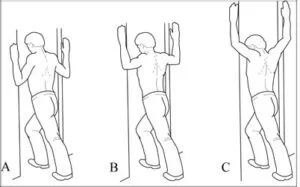
- This stretching will help lessen your chest stiffness and shoulders. Place your elbows and hands in line with a doorframe.
- Step through the door gradually, until you feel a stretch.
- Maintain this end position for 30 seconds before returning to the initial position. perform this stretch three times.
Thoracic Extension Variation
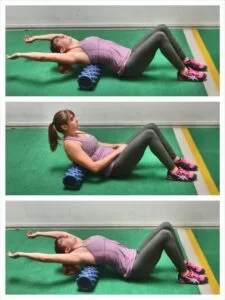
- According to research, people with shoulder impingement who add a thoracic extension into their treatment experience better outcomes than people who don’t. Therefore, it’s usually a good idea to increase the range before loading.
- Make use of a foam roll or a yoga mat that has been compressed. Place the foam roller just behind your shoulder blades as you lie on your back with your knees flexed and your feet flat on the ground.
- Your thoracic spine should be extended over the foam roll while you place your hands behind your head and complete the “J-loop” 10 times of holding for 5 to 10 seconds each. a suggested set and repetitions you have to complete.
Strengthen rotator cuff muscles
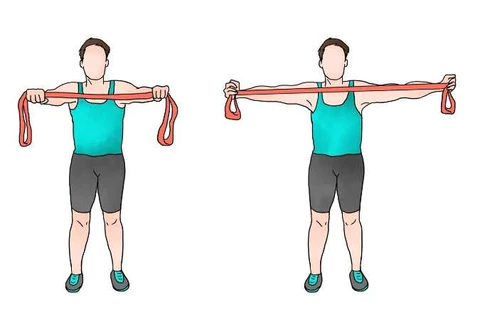
- Weak rotator cuff muscles are one of the main reasons for shoulder impingement, so we want to concentrate on strengthening these first so we are capable of re-training the body on how to move the shoulder properly.
- Start by standing against the wall holding the resistance band with your hands up and your elbows bent at the side.
- Pull the band apart by twisting the shoulders externally while squeezing the shoulder blades together.
- Keep your forearms tucked in throughout; there shouldn’t be much room between your body and your elbow.
- 3 sets of 10 reps should be your goal.
Floor Cobra Raises

- This exercise is designed to help you improve your posture by strengthening the muscles in your middle and lower trapezius.
- Lie on your back with your palms facing the ground.
- Raise your arms off the floor by gradually rotating them from the outside.
- Hold a shoulder blade squeeze for one to two seconds.
- Do three sets of 10 repetitions each.
Wall Angels

- This exercise opens up the shoulders and chest while strengthening the serratus anterior and low trapezius muscles.
- Try to maintain your upper back and buttocks in contact with the wall as you stand with your back to the wall and step your feet out about 12 inches from the wall.
- To prevent an excessive low back arch, draw your tummy towards the wall.
- Try to press your forearms on the wall while bending your elbows to 90 degrees so that your hands are pointing up (this position could feel awkward when you first begin this exercise).
- Slide your arms slowly up the wall, then slide them back down.
- Start with one set of 10 repetitions and increase to three sets as you gain strength.
- These shoulder impingement exercises should be beneficial for you, and we hope you enjoyed them.
Shoulder Blade Squeeze

- Squeeze the muscles between your shoulder blades while keeping your arms at your side. Five seconds in, then release the position. 10 times is a repeat
Crossover Arm Stretch

- Put one arm across your upper body, and with the other, hold the first arm in the gap between your second and third arms. When you begin to feel the muscles in the back of your shoulder stretch, pull towards your chest. Relax after holding for 5 seconds. 10 times total.
Isometric Shoulder Internal and External Rotation
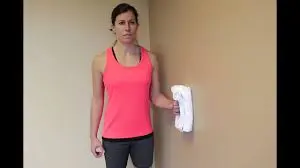
Internal rotation
External rotation
This practice strengthens the rotator cuff muscles and tendons near your shoulder joint, raising how much weight your shoulder can support.

- Put a rolled-up towel under the arm of the shoulder that is undergoing pain.
- Stand at the corner of a wall with your elbow flexed at a ninety-degree angle in front of you.
- Push into the wall with a flat hand with 25 to 50 percent force.
- Maintain the push for ten seconds, repeating the exercise ten times. This is known as an internal rotation.
- Then, turn your body such that you may force your hands outside against the wall. Use the outside of your hand to apply 25 to 50 percent pressure to the wall.
- Maintain the push for 10 seconds, repeating the exercise 10 times. This is the external rotation.
You might feel a mild burn on the outside of the shoulder when doing this exercise. Slowly, you can build up to a stronger pressure, as long as it does not cause pain.
Side-Lying Shoulder External Rotation
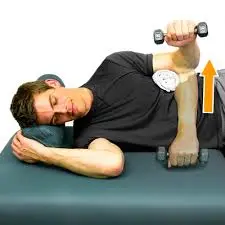
- Utilize the same rolled-up towel under your arm as in the above exercise. (The towel makes the arm position more efficient and assists in preventing overcompensation.)
- Lie on your affected side with your head neutrally supported by a cushion.
- Lift a lightweight object straight up from the surface you’re on until it is in line with your shoulder while keeping your top arm bent at a 90-degree angle in front of you.
- Slowly bring it back down.
- If your body can handle it, perform the lift three times for three sets of ten, or go straight for thirty. You can eventually raise the weight by up to five pounds.
Shoulder Scaption Exercise
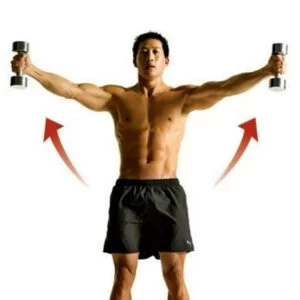
- Carry a water bottle or other small object beside the afflicted side while standing.
- Lift that arm gradually until it is 45 degrees away from your body and fully stretched.
- Retract your arm slowly until it is at your side.
- If necessary, take a break between sets to reduce shoulder fatigue, or continue until 30 repetitions of the lift. You can gradually raise the weight to five pounds.
How Can I Start Rehabbing and Working Out My Shoulder?
The good news is that you do not have to wait until your shoulder no longer hurts to do the exercises recommended. The above exercises are simple and low-level enough that they will assist with everything that is going on in the shoulder. Gentle activities like the three above get the shoulder joint and muscles moving again while permitting inflammation to go down.
However, if the above exercises cause a significant amount of pain (say, a 4 or above on a scale of 1 to 10, with 10 being great pain), you should hold off and rest your shoulder longer, You should also consult your PT now. He or she may be able to modify the dosage (e.g., suggest doing fewer reps or using less resistance), or help you dial in your form better.
There are other commonly safe exercises you can do to strengthen the shoulder while it recovers. You do not technically have to move the shoulder to strengthen it. Performing the muscles that attach to the shoulder can help you maintain or even gain strength when you have a pain flare-up.
As your pain improves, you will be able to experiment with the exercises you are probably used to and add them back into your training one at a time. But it is important not to speed up the process. You may not be able to do a dumbbell or barbell overhead press for a period, but you may find that a landmine press done from a half-kneeling position feels okay. The arc that the bar travels in a landmine press does not stress the shoulder joint so directly, so many people find that it allows them to train the shoulder with a full range of movement without pain, with the extra advantage of strengthening the serratus anterior, which arrives the shoulder blade to the ribcage, stabilizing it.
Which exercise you should avoid with shoulder impingement?
- Avoid the Activities that cause you more pain
- Avoid overhead activities like throwing and lifting.
- Avoid some sports activities which can use your shoulder like badminton, tennis and cricket.
- If you are a gym lover then do some leg exercises for a few days and avoid upper limb exercises.
Many times people can continue doing their favorite sports and exercises with a shoulder impingement, as long as you adjust intensity.
If you advise the person who loves swimming to stop, they are not going to stop, or they are going to be bleak, so it’s not worth telling them to stop. “They should simply scale it back.”
If you can not manage to do the exercise comfortably at any intensity, find another exercise to keep you active until you have recovered enough to try again. This way, you can support your strength, overall activity level, and mobility while giving your shoulder a rest.
Summary
Shoulder impingement typically happens due to a person overusing the shoulder. Swimmers, baseball players, and other athletes may be more likely to experience this type of harm.
People working in occupations that need a lot of lifting may also be more likely to participate in shoulder impingement.
Preventing shoulder impingement by learning how to raise and move the shoulder perfectly may be the best method to avoid injury. Most people react well to simple treatments, such as rest and physical therapy. NSAIDs can also assist in decreasing pain and inflammation.
Anyone uncertain about their symptoms or therapy options should talk to a doctor.
FAQ
What is the quickest method of treatment for a shoulder impingement?
Impingement syndrome can be cured with ice, over-the-counter irritant, rest and pain relievers steroid injections, and physical therapy. The most important kind of treatment for shoulder impingement syndrome is physical therapy.
Can anyone with shoulder impingement perform shoulder exercises?
Although it’s recommended to rest your shoulder, you can strengthen your rotator cuff while also doing some mild exercises to stretch the muscles in your arm, shoulder, and chest. These exercises will aid in preventing the aggravation of shoulder impingement pain.
Should I massage my impinged shoulder?
In addition to reducing pain and discomfort, massage helps patients maintain good posture, which can help stop explosions from happening in the future and long-term damage from occurring.
What exercises should I avoid performing if my shoulder is impinged?
Exercises to Avoid with Shoulder Impingement
Avoid weightlifting until you are recovered because it can be dangerous, especially overhead presses or pull-downs.
Until you have fully recovered, completely avoid swimming.
What kind of physical therapy is most effective for shoulder impingement?
The following shoulder impingement syndrome exercises may help you feel better:
Scapula Squeeze.
Scapula Push and Pull.
Chest Stretch.
Front Shoulder Stretch.
Back Shoulder Stretch.
Lying External Rotation.
Is shoulder impingement treated better with heat or ice?
When you initially suffer an injury, ice is used to reduce pain, swelling, and inflammation. After the swelling has subsided, we concentrate on using heat-based therapies to improve local blood circulation and activate the body’s natural healing process.
Can physiotherapy treatment heal the shoulder impingement?
Exercise therapy alone can frequently reverse shoulder impingement. Between 70% and 90% of individuals with shoulder impingement will make a full recovery with the proper rehabilitation.
References
- Johnson, J. (2019b, November 14). What to know about shoulder impingement.
- Mph, B. S. D. (2023, July 3). Shoulder Impingement Exercises You Can Do At Home. Back Intelligence.
- Exercises for shoulder impingement Syndrome Kentucky | Shoulder Surgery Kentucky. (n.d.).
- Bedosky, L. (2023). 5 Shoulder impingement exercises to boost recovery. Onnit Academy.







